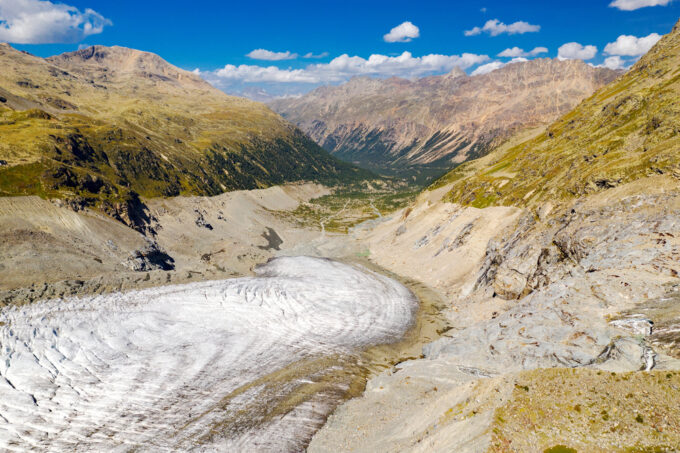Climate change particularly pronounced in Switzerland
Switzerland is becoming hotter, drier, less snowy and will have to contend with heavier rainfall in the future: This is the conclusion reached by climate researchers from the Federal Office of Meteorology and Climatology MeteoSwiss and ETH Zurich. On November 4, 2025, they presented the new climate scenarios for Switzerland in the presence of Federal Councillor Elisabeth Baume-Schneider. They form the basis for the Federal Council's strategy for adapting to climate change.

Tropical nights are making it difficult for people in cities to sleep, vegetable farmers are struggling with excessively dry soils and homeowners are preparing for the threat of flooding - a future that is foreseeable if climate change continues unabated, according to the results of the new Swiss climate scenarios. Many of the effects can already be measured and felt today. «The new climate scenarios give us a more concrete picture of climate change in Switzerland over the coming decades. They help us to assess developments and plan suitable measures - to protect our environment, our cities and our agriculture,» said Federal Councillor Elisabeth Baume-Schneider during the presentation.
The four main changes in the climate scenarios
The new scenarios drawn up by MeteoSwiss on behalf of the federal government build on the results of the 2018 climate scenarios. They confirm and expand the previously known picture of climate change in Switzerland. The current warming in Switzerland (2024: +2.9°C since pre-industrial levels) is higher than the global average (2024: +1.3°C). Aspects of climate change are more pronounced in Switzerland than the global average, partly due to its geographical location. For example, with global warming totaling 3 degrees, the temperature in Switzerland will rise significantly more, namely by around 4.9°C.
Such warming has countless effects. The climate scenarios describe four main changes that will shape the climate in Switzerland in a world that is 3 degrees warmer globally:
- More extreme heat
Heat events particularly affect regions at low altitudes and especially urban areas. However, they may also occur increasingly in regions in the Alps and Alpine foothills in the future. The hottest day of the year will be around 4.4°C hotter on average (compared to 1991-2020). Hot days and tropical nights will also occur much more frequently. In the city of Zurich, for example, an average of around five times more tropical nights per year are expected. - Drier summers
Soils in Switzerland will increasingly dry out in summer. This is due to higher temperatures, greater evaporation and less summer precipitation. Summer drought has already increased over the past 40 years or so. A typical summer drought will be 44% more intense in the future. Droughts and the risk of forest fires will increase. - Heavy and more frequent heavy precipitation
Heavy precipitation will increase in all seasons in the long term. The highest increases are expected above all for heavy thunderstorm precipitation that falls in a very short time. In summer, more intensive precipitation does not rule out a simultaneous decrease in the total amount of precipitation: Although it rains less frequently, larger amounts of rain fall in a short period of time during individual events. - Rise in the zero degree limit and less snow
Precipitation will increase slightly in winter, but will fall more as rain rather than snow. The average zero degree line in winter will rise by 550 meters to around 1450 meters. The natural snow cover will continue to decrease in the future, especially at low altitudes, as a result of increasing warming and the resulting rise in the zero degree line.
Adaptation to climate change is becoming more important
Measures to reduce emissions mitigate the consequences of climate change. The federal government also supports the Swiss population in adapting to extreme events with measures that are decided on the basis of climate scenarios. These include increasing heat, drier summers, more intense precipitation and less snow. The 2025 climate scenarios use global warming levels to show what global climate targets mean for Switzerland. In the Paris Agreement, Switzerland made a commitment to the international community to limit global warming to well below 2°C - ideally to 1.5°C - compared to pre-industrial levels. Reducing emissions worldwide is essential to limit the consequences of climate change. The climate scenarios show the impact of climate protection measures on climate change - every tenth of a degree saved can reduce the impact on Swiss nature, society and the economy. «With ambitious climate protection and net zero emissions globally by 2050, most of the future long-term warming and thus many of the resulting further effects could be avoided,» said Reto Knutti, climate researcher at ETH Zurich.
With all efforts, global warming can at best be limited, but not reversed. The 2025 climate scenarios are a central and regularly updated service and form the planning basis for the Federal Council's strategy for adapting to climate change. Any avoided warming makes a measurable contribution to climate protection and reduces the cost of adaptation. Nevertheless, adaptation to climate change is becoming increasingly important.
Source: ETH Zurich









